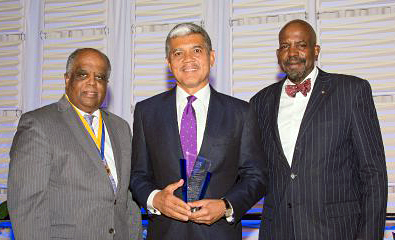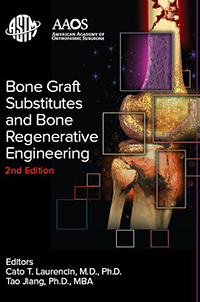 I am pleased to announce Paulos Mengsteab, a graduate student in the Institute for Regenerative Engineering, has received funding from a NIH/NIAMS supplemental grant which will support his Ph.D. studies. This supplemental grant to our current NIH R01 grant, “A Translational Approach to Ligament Regeneration,” evaluates the efficacy of surface modulation of a previously established 3D braided biomimetic tissue-engineered scaffold.
I am pleased to announce Paulos Mengsteab, a graduate student in the Institute for Regenerative Engineering, has received funding from a NIH/NIAMS supplemental grant which will support his Ph.D. studies. This supplemental grant to our current NIH R01 grant, “A Translational Approach to Ligament Regeneration,” evaluates the efficacy of surface modulation of a previously established 3D braided biomimetic tissue-engineered scaffold.
The Research Supplements to Promote Diversity in Health-Related Research Program supports the NIH’s efforts to diversify research fields. Specifically, it recruits individuals from underrepresented racial and ethnic groups, those with disabilities, and individuals from disadvantaged backgrounds. The program fosters improvements in the quality of educational environments, broaden perspectives in research priorities, and improve the nation’s capacity to address and eliminate health disparities.
Paulos graduated with a B.S. in Mechanical Engineering from the University of Missouri-Columbia in 2013. While studying for his degree, Paulos founded a student organization called ‘Step In’ which worked with the Columbia Public Schools in closing the educational achievement gap among races by encouraging underrepresented minorities and disadvantaged students, through applied learning modules, to participate in the STEM fields. Paulos was also selected to participate in the Ronald E. McNair Scholar’s Program and was awarded funding to conduct research under the supervision of Dr. Ahmed Sherif El-Gizawy’s. After graduating, he was awarded the NIH Post-Baccalaureate Education Program Fellowship at the University of Washington, where he conducted research in the Biomedical Engineering Department under the supervision of Dr. Doek-Ho Kim. His primary research project at University of Washington focused on primary cardiomyocytes contractile behavior in response to dynamic nanotopography surfaces. In Fall 2014, Paulos joined the Institute for Regenerative Engineering as a Ph.D. student enrolled in the Biomedical Engineering program at the University of Connecticut.
 I am pleased to announce Paulos Mengsteab, a graduate student in the Institute for Regenerative Engineering, has received funding from a NIH/NIAMS supplemental grant which will support his Ph.D. studies. This supplemental grant to our current NIH R01 grant, “A Translational Approach to Ligament Regeneration,” evaluates the efficacy of surface modulation of a previously established 3D braided biomimetic tissue-engineered scaffold.
I am pleased to announce Paulos Mengsteab, a graduate student in the Institute for Regenerative Engineering, has received funding from a NIH/NIAMS supplemental grant which will support his Ph.D. studies. This supplemental grant to our current NIH R01 grant, “A Translational Approach to Ligament Regeneration,” evaluates the efficacy of surface modulation of a previously established 3D braided biomimetic tissue-engineered scaffold. I am pleased to announce M. Roy Wilson, president of Wayne State University, is the recipient of the 2015 Cato T. Laurencin, M.D., Ph.D., Lifetime Research Award. Dr. Wilson received his M.D. degree from Harvard Medical School and his Master of Science in epidemiology at the UCLA School of Public Health. Dr. Wilson is an accomplished researcher focused on glaucoma and blindness in West Africa, the Caribbean, and urban communities in the United States. He is an elected member of the National Academy of Medicine, the American Ophthalmological Society, and the Glaucoma Research Society.
I am pleased to announce M. Roy Wilson, president of Wayne State University, is the recipient of the 2015 Cato T. Laurencin, M.D., Ph.D., Lifetime Research Award. Dr. Wilson received his M.D. degree from Harvard Medical School and his Master of Science in epidemiology at the UCLA School of Public Health. Dr. Wilson is an accomplished researcher focused on glaucoma and blindness in West Africa, the Caribbean, and urban communities in the United States. He is an elected member of the National Academy of Medicine, the American Ophthalmological Society, and the Glaucoma Research Society. I am happy to announce that Springer Publishing has officially launched the international journal, Regenerative Engineering and Translational Medicine in partnership with the newly formed Regenerative Engineering Society. The new journal will cover the convergence of multiple fields including tissue generation, advanced materials science, stem cell research, the physical sciences, and developmental biology. The senior editorial team includes managing editor, Lakshmi S. Nair, MPhil, PhD, and assistant managing editor, Tao Jiang, PhD, MBA, both of the University of Connecticut; and news and views editor, Ali Khademhosseini, PhD, of Harvard University. Regenerative Engineering and Translational Medicine is currently seeking submissions. For information and online submission instructions, please visit the
I am happy to announce that Springer Publishing has officially launched the international journal, Regenerative Engineering and Translational Medicine in partnership with the newly formed Regenerative Engineering Society. The new journal will cover the convergence of multiple fields including tissue generation, advanced materials science, stem cell research, the physical sciences, and developmental biology. The senior editorial team includes managing editor, Lakshmi S. Nair, MPhil, PhD, and assistant managing editor, Tao Jiang, PhD, MBA, both of the University of Connecticut; and news and views editor, Ali Khademhosseini, PhD, of Harvard University. Regenerative Engineering and Translational Medicine is currently seeking submissions. For information and online submission instructions, please visit the  The Institute for Regenerative Engineering has published the landmark book Bone Graft Substitutes and Bone Regenerative Engineering. The book provides a well-rounded and articulate summary of the present status of using allogeneic, xenogenic, and synthetic bone graft substitutes to reconstruct bone tissues. To reflect on the importance of the concept of convergence, Bone Graft Substitutes and Bone Regenerative Engineering captures the excitement of the new field we call Regenerative Engineering. The chapters of the book are written by the leading researchers in academia, surgeons, industry leaders and regulatory specialists. We believe this new book, following the very successful first edition entitled Bone Graft Substitutes, will be of value to people who work in all fields involving bone. I thank Dr. Tao Jiang, my co-editor, for his time and effort in working with me. In addition, the publication of this book would be impossible without the assistance from numerous people at ASTM International. Finally, I also want to thank the Raymond and Beverly Sackler Foundation for their tremendous support in all our efforts to define the new field of Regenerative Engineering.
The Institute for Regenerative Engineering has published the landmark book Bone Graft Substitutes and Bone Regenerative Engineering. The book provides a well-rounded and articulate summary of the present status of using allogeneic, xenogenic, and synthetic bone graft substitutes to reconstruct bone tissues. To reflect on the importance of the concept of convergence, Bone Graft Substitutes and Bone Regenerative Engineering captures the excitement of the new field we call Regenerative Engineering. The chapters of the book are written by the leading researchers in academia, surgeons, industry leaders and regulatory specialists. We believe this new book, following the very successful first edition entitled Bone Graft Substitutes, will be of value to people who work in all fields involving bone. I thank Dr. Tao Jiang, my co-editor, for his time and effort in working with me. In addition, the publication of this book would be impossible without the assistance from numerous people at ASTM International. Finally, I also want to thank the Raymond and Beverly Sackler Foundation for their tremendous support in all our efforts to define the new field of Regenerative Engineering. On April 9, I gave a plenary lecture as part of the Institute for Medical Engineering & Science (IMES) Distinguished Speaker Series at MIT. My talk highlighted the importance of convergence research as illustrated by some of our recent work in the Institute for Regenerative Engineering.
On April 9, I gave a plenary lecture as part of the Institute for Medical Engineering & Science (IMES) Distinguished Speaker Series at MIT. My talk highlighted the importance of convergence research as illustrated by some of our recent work in the Institute for Regenerative Engineering. On February 7th and 8th, I participated in the 2015 Musculoskeletal Development and Regeneration Conference in Cancun, Mexico. My speech, “Regenerative Engineering: The Theory and Practice of a Next Generation Field,” highlighted the future of regenerative engineering in musculoskeletal repair and regeneration. I discussed the challenge of musculoskeletal tissue engineering and several of the latest inventions developed by the Institute for Regenerative Engineering here at UConn Health including a bioengineered matrix for the regeneration of torn anterior cruciate ligaments. I want to thank the organizers for including me as part of this for those working on the frontiers of science in both academia and corporate industry.
On February 7th and 8th, I participated in the 2015 Musculoskeletal Development and Regeneration Conference in Cancun, Mexico. My speech, “Regenerative Engineering: The Theory and Practice of a Next Generation Field,” highlighted the future of regenerative engineering in musculoskeletal repair and regeneration. I discussed the challenge of musculoskeletal tissue engineering and several of the latest inventions developed by the Institute for Regenerative Engineering here at UConn Health including a bioengineered matrix for the regeneration of torn anterior cruciate ligaments. I want to thank the organizers for including me as part of this for those working on the frontiers of science in both academia and corporate industry. I am very happy to announce the launch of a new journal entitled Regenerative Engineering and Translational Medicine. It will be published quarterly beginning in later 2015.
I am very happy to announce the launch of a new journal entitled Regenerative Engineering and Translational Medicine. It will be published quarterly beginning in later 2015.